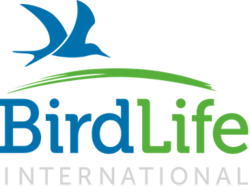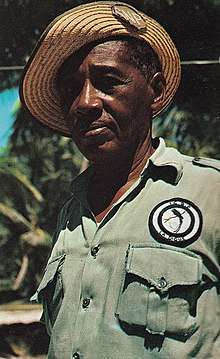BirdLife International
BirdLife International is a global partnership of non-governmental organizations that strives to conserve birds and their habitats.[1] BirdLife International's priorities include preventing extinction of bird species, identifying and safeguarding important sites for birds, maintaining and restoring key bird habitats, and empowering conservationists worldwide.
 | |
| Motto | Partnership for Nature and People |
|---|---|
| Formation | 1922 |
| Type | INGO |
| Purpose | Conservation |
| Headquarters | Cambridge, United Kingdom |
Region served | Worldwide |
Chairman | Braulio Ferreira de Souza Dias |
Chief executive | Patricia Zurita |
| Website | www |
Formerly called | International Council for Bird Preservation |
It has a membership of more than 2.5 million people across 116 country partner organizations, including the Royal Society for the Protection of Birds, the Wild Bird Society of Japan, the National Audubon Society and American Bird Conservancy.[2]
BirdLife International has identified 13,000 Important Bird and Biodiversity Areas and is the official International Union for Conservation of Nature’s Red List authority for birds.[3][4] As of 2015, BirdLife International has established that 1,375 bird species (13% of the total) are threatened with extinction (critically endangered, endangered or vulnerable).[5]
BirdLife International publishes a quarterly magazine, BirdLife – The Magazine, which contains recent news and authoritative articles about birds and their conservation.[6]
History

BirdLife International was founded in 1922 as the International Council for Bird Preservation by American ornithologists T. Gilbert Pearson and Jean Theodore Delacour under the name International Committee for Bird Protection. The group was renamed International Committee for Bird Preservation in 1928, International Council for Bird Preservation in 1960, and "BirdLife International" in 1993.[7]
Global programmes
BirdLife International has nine conservation programmes implemented across Africa, the Americas, Asia, Europe and Central Asia, the Middle East and the Pacific.[8] The programmes provide the framework for planning, implementing, monitoring and evaluating conservation work and include the Important Bird and Biodiversity Areas Programme,[9] Marine Programme[10], Preventing Extinctions Programme[11][12], and Flyways Programme.[13]
References
| Wikimedia Commons has media related to BirdLife International. |
- "BirdLife Partners". BirdLife International. Retrieved 30 August 2015.
- International, BirdLife. "ABC joins the flock!". BirdLife. Retrieved 18 July 2020.
- "Red List Authority for birds".
- International, BirdLife. "Sites & Habitats (IBAs and KBAs)". BirdLife. Retrieved 7 July 2020.
- "Birds". iucn.org. 19 January 2016.
- "BirdLife's World Bird Club". BirdLife International. Retrieved 30 August 2015.
- "Our History". BirdLife International. Retrieved 30 August 2015.
- "Regions". BirdLife International. Retrieved 30 August 2015.
- Donald, Paul F.; Fishpool, Lincoln D. C.; Ajagbe, Ademola; Bennun, Leon A.; Bunting, Gill; Burfield, Ian J.; Butchart, Stuart H. M.; Capellan, Sofia; Crosby, Michael J.; Dias, Maria P.; Diaz, David (June 2019). "Important Bird and Biodiversity Areas (IBAs): the development and characteristics of a global inventory of key sites for biodiversity". Bird Conservation International. 29 (2): 177–198. doi:10.1017/S0959270918000102. ISSN 0959-2709.
- "New research shows sustainable fishing and conservation can coexist". MercoPress. Retrieved 8 July 2020.
- Platt, John R. "Nextinction: Ralph Steadman Goes Gonzo for Endangered Birds". Scientific American Blog Network. Retrieved 8 July 2020.
- Stevens, Cressida (1 July 2019). "New Partnership To Protect Underdog Species From Direct Threats - Four leading NGOs have joined forces through Restore Species to tackle illegal and unsustainable hunting & trade as well as poisoning of animal species worldwide". Conservation Frontlines. Retrieved 8 July 2020.
- "What Saudi Arabia, neighbors are doing to protect bird migratory routes in the Middle East". Arab News. 11 May 2019. Retrieved 8 July 2020.
External links
| Wikidata has the property: |